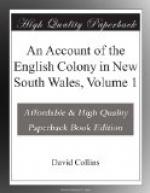Charles Williams, the settler so often mentioned in this narrative, wearied of being in a state of independence, sold his farm with the house, crop, and stock, for something less than one hundred pounds, to an officer of the New South Wales corps, Lieutenant Cummings, to whose allotment of twenty-five acres Williams’s ground was contiguous. James Ruse also, the owner of Experiment farm, anxious to return to England, and disappointed in his present crop, which he had sown too late, sold his estate with the house and some stock (four goats and three sheep) for forty pounds. Both these people had to seek employment until they could get away; and Williams was condemned to work as a hireling upon the ground of which he had been the master. But he was a stranger to the feelings which would have rendered this circumstance disagreeable to him.
The allotment of thirty acres, late in the possession of James Richards, a settler at the Ponds, deceased, was put into the occupation of a private soldier of the New South Wales corps; and a grant of thirty acres at the Eastern Farms was purchased for as many pounds by another soldier.
The greatest inconvenience attending this transfer of landed property was the return of such a miscreant as Williams, and others of his description, to England, to be let loose again upon the public. The land itself came into the possession of people who were interested in making the most of it, and who would be more studious to raise plentiful crops for market.
Building and covering the new barrack, and bringing in timber for the new mill-house, which was not to be built of brick, formed the principal labour of this month at Sydney. The shipwrights were employed in putting up the frame of a long-boat purchased of the master of the Britannia, and repairing the hoy, which had been lying for some months useless for want of repairs, having been much injured by the destructive worm that was found in the waters of this cove.
At the other settlements the convicts were employed in planting the Indian corn. About four hundred and twenty acres were planted with that article for this season’s crop.
November.] In the night of Thursday the 7th of November, the Francis schooner anchored in the cove from Dusky Bay in New Zealand; her long absence from this place (nearly nine weeks) having been occasioned by meeting with contrary and heavy gales of wind. The alteration which had been made in this vessel by rigging her as a schooner instead of a sloop, for which she was built, was found to have materially affected her sailing; for a schooner she was too short, and, for want of proper sail, she did not work well. Four times she was blown off the coast of New Zealand, the Britannia having anchored in Dusky Bay sixteen days before the Francis.




